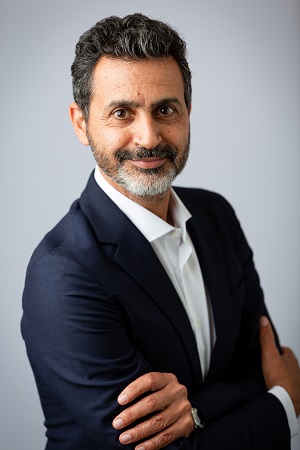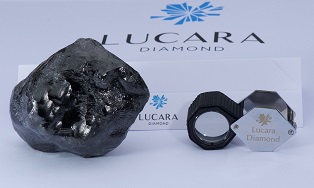RAPAPORT... It’s not often a newcomer sweeps in to buy the largest diamond available on the market. Such deals are usually reserved for high-end jewelers such as Graff, Moussaieff, Harry Winston, or even large-scale retailers like Chow Tai Fook or Tiffany & Co.
But the sale of the 1,758-carat Sewelô in January by Lucara Diamond Corp. raised eyebrows for the two entities that scooped the apparently unattractive but high-profile rough stone. Louis Vuitton, better known for fine leather than fine jewelry, partnered on the deal with a relatively unknown new business in the industry: HB Antwerp.
Barely a year old, HB’s progress has been swift. In the eight months since the Sewelô purchase, the company has made some aggressive hires and acquisitions. HB is now Belgium’s largest diamond manufacturer, claimed CEO and managing partner Oded Mansori in an interview with Rapaport News last week.
Mansori, an Israeli-born diamantaire whose résumé includes stints at sightholders A. Dalumi and Steinmetz and big-stone specialist Rare Diamond House, cofounded HB last year with supply-chain expert Shai de Toledo and business-development executive Rafael Papismedov. The trio soon started to make waves.
Aggressive expansion
In late 2019, HB bought the Scientific and Technical Research Center for Diamond (WTOCD), a technology unit owned by the Antwerp World Diamond Centre (AWDC) that had been working on automated cutting equipment. It has also taken over two Antwerp polishing factories — one from sightholder AMC Diamonds, the other undisclosed — and estimates its monthly polished production to be in the “tens of millions” of dollars. The AMC transaction, which it announced last week, brought in 13 employees, as well as machinery and technology.
Meanwhile, HB has recruited Boaz Lev, the long-standing managing director of Malca-Amit’s Belgium division, to serve as its operations director and as a managing partner, and has tapped the AWDC’s Margaux Donckier as director of communications and external affairs.
Whereas HB employed just six people in March 2020, Mansori expects its workforce to grow to around 70 by the end of the year — most of them cutters, with around half coming from acquisitions and half from conventional hiring.
All this despite the coronavirus crisis, which paralyzed the rough-diamond market and the manufacturing sector during that same period. If anything, the downturn has accelerated HB’s development, as some elements of the expansion were supposed to take place next year, Mansori notes. For example, in July the company agreed to purchase all Lucara’s rough above 10.8 carats for the remainder of the year. That bulk deal was being planned for 2021, but the parties brought it forward because of the pandemic, he reveals.
“The situation presented us with the opportunity, together with our partners, to initiate much earlier,” the cofounder explains. “In a way, it worked to our benefit, because we kept on operating throughout the entire crisis. And we have achieved very, very good results that are satisfying all our partners.”
Inefficient big-stone market
Mansori is active in the large-stone market, which has struggled more than most sectors in the recent global crises. The RapNet Diamond Index (RAPI) for 3-carat polished fell 16% in 2019 when an oversupply plagued the diamond industry. The index is down more than 4% this year in the shadow of the Covid-19 pandemic.
This downward trend comes from a major inefficiency in the segment, Mansori says. The large-diamond market is highly sensitive to every new selling price because there are so few deals, he explains. One distressed player offloading goods at discounts brings prices down for everyone.
“That one player that was weak and had to liquidate…created an everlasting lower benchmark,” Mansori recalls of his experience with the traditional format. “Once a 10-carat is sold for whatever amount per carat, this becomes the benchmark.”
This is a consequence of the industry being too large and containing players that lack financial stability and aren’t selling purely to make long-term profits, Mansori argues. These problems have led him toward a new strategy that envisages a more efficient market consolidated into a smaller number of stronger players competing in a healthy way.
“The [companies] that are here as hitchhikers, temporarily, that have no vision, that are only seeking their immediate profit without investing in technology or in the future — the writing’s on the wall,” he predicts.
The outlook has fueled HB’s expansion in recent months. Self-funded, with no bank financing, it wants to be one of the few and robust businesses that will transform the big-stone market, and the broader diamond industry.
Matching supply and demand
At the core of HB’s strategy is its technology-based program called Signum, which matches demand with supply. It resembles Lucara’s Clara platform, which enables manufacturers to buy the exact rough they require based on polished needs. In addition to Lucara, HB is working with two more miners and a “handful of retailers” around the world, Mansori reports.
Mansori won’t say who the other partners are, and is evasive about the details of his plans. He refuses even to disclose what HB stands for. All of this will become clear in the middle of next year, he asserts. But HB’s website give a few indications: The company offers retailers a service sourcing rough directly from the mine, with the company conducting the entire manufacturing process in Antwerp and verifying every step using blockchain technology. It also pitches a program for miners that enables them to sell their rough at a price based on the estimated polished outcome, similar to the arrangement with Lucara. The Signum matching service will be key. In the traditional system, manufacturers buy volumes of rough to access the goods they want, but often end up with items they don’t want. This is especially the case in the De Beers and Alrosa contract-sales systems. Like Lucara, HB wants to change this, and notes that there is always demand for every diamond somewhere in the world. “We have a lot of respect for what Clara and Lucara are doing,” he continues. “We see a lot eye to eye. The biggest difference between us [and the traditional industry] is that our operation is demand-driven and not supply-driven. Our operation is based on pull and not on push.” This customization aspect will feed into Mansori’s ambition to rid the industry of the need to offload unwanted goods. Most of the rough HB buys already has an order for the polished, he notes. “The old way of buying quantity, processing it and then looking for a client forces you to sit on stock and forces you to freeze money,” he explains. “That forces you to reduce prices in order to get rid of items that you don’t know how to sell. That forces your competitors to sell their goods at a lower price.” HB’s deals have already had a positive effect on the big-stone market, Mansori acknowledges. “We don’t want to take the credit for it, but once there is less supply available and a smaller number of players acting, that will have a direct impact on the pricing,” he says. Sewelô’s secret
 As for the Sewelô, Louis Vuitton is currently showing the stone to potential buyers of the final polished on a world tour, alongside design plans. The end consumer will choose the result he or she wants, at which point the rough will enter the manufacturing phase, Mansori reveals. “Louis Vuitton is doing a very good job of creating a link to the end user, telling the beautiful story of diamonds from mine to finger, in such a transparent way, and allowing the customer to be involved in the entire decision-taking process,” Mansori elaborates. The rough appears black but “holds a secret within,” he says. “There’s a very big surprise in the stone. And we are big believers that the outcome will be even more fascinating than what [you can see] now.” HB wants to continue growing, adding more members to its team, as well as more partners to its program. But Mansori isn’t just seeking the old style of “cutter who sits on the wheel and just executes” — he wants polishers with creative and strategic minds. “There’s an artistic part that they can contribute,” he explains. “We are selectively picking them up one by one — the best of talent and the best of people.” Main image: Oded Mansori. Inset: The Sewelô diamond. (HB Antwerp, Lucara Diamond Corp.)
|